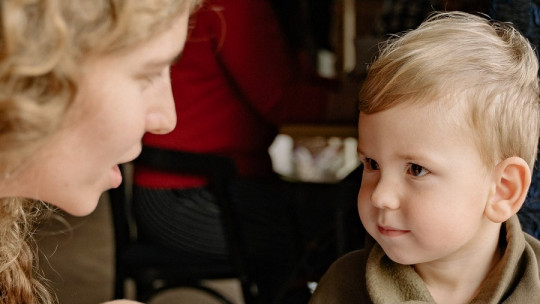Surely this situation sounds familiar to you: a father who goes to pick up his daughter from school and when passing in front of a kiosk disconsolately asks her to buy him a chocolate bar. The father, who as he well knows has the snack waiting at home, tells him that he cannot buy it for him.
That is when the daughter realizes that her search for the chocolate bar is being frustrated and that is when she begins to scream, cry and even stretch out her father’s arm to get him to buy her what she wants. This is an unequivocal example of a tantrum Let’s see what this phenomenon consists of and how we can manage it in boys and girls.
Why do tantrums occur?
Tantrums are a natural process that all human beings go through A tantrum is nothing more than a form of expression of frustration at not being able to get what the person wants. In this case, that expression manifests itself through an explosion of anger, crying and uncontrolled rage.
Between 18 and 36 months, children go through so-called primary tantrums These are necessary for the psycho-emotional development of boys and girls. At this stage they seek to explore the world and begin to express their desires, beyond what parents want them to do.
At this stage the child begins to develop autonomy and begins to have his or her own desires. The way that the child at this age tries to express his/her preferences and tastes is tantrums, since does not yet have a sufficiently developed language to make requests to their parents.
On the other hand, at this stage they have not yet developed, at the brain level, the areas involved in self-control That is why boys and girls initially begin to develop self-regulation and control of their emotions through tantrums.
Tantrums may mean that there is some other problem if they persist beyond the age of 4 and if it is very difficult to calm them down. In cases in which the boy or girl always expresses his or her frustration and anger through tantrums during this age, it may be indicating that something else is happening (parental divorce, problems with other children, the arrival of a sibling). , etc.).
What can we do in the event of a tantrum?
As we have seen, tantrums are part of people’s evolutionary development. However, After 36 months of age, tantrums should begin to decrease considerably Although they decrease, it is important to know what we can do so that they do not persist over time and progressively disappear.
First of all, there are factors that can increase the likelihood of a tantrum: fatigue, sleep, hunger, unpleasant environmental conditions such as excess heat, cold , luminosity, etc. It is important that we take into account if the tantrum is occurring due to any of these factors and try to correct them.
But the truth is that in most cases tantrums are usually the expression of a frustrated desire when the child asks us for something and we don’t give it to them or when we take away something that they want or that they liked. It is in those moments when we must apply the following strategies.
1. Never give in to the tantrum
If through that behavior the boy or girl gets what he or she wants, only We will be teaching him that tantrums are a means to achieve his desires
2. Show calm
Or, at least, not show that we are affected by his tantrum.
3. Prevent possible situations
For example: if we know that he is hungry when he leaves school, avoid passing by places where he may ask us to buy him something.
4. Try to divert their attention if we see that a tantrum is imminent.
Usually, There are signs that indicate that he is beginning to become irritated If we know how to identify these elements, we can capture their attention and focus it on something different to try to prevent the tantrum from appearing.
5. Not paying attention to crying
It is important that when the tantrum appears we do not pay attention We must monitor the boy or girl and what he or she does to prevent him or her from harming himself, but we must try to ignore him or her. We can change rooms in the house, continue as if nothing had happened. Our attention is the strongest reward for them and therefore we must teach them that with negative behaviors they will not get anything from us.
6. If we are away from home: we should try to avoid going through dangerous places
We avoid looking at him or answering him but at all times we pay attention to know that he cannot hurt himself. If we see that she wants to flee, we hold her so she doesn’t move but without saying anything.
The importance of showing coherence and consistency with the rules
It is important that we see that there will be times when we will surely end up giving in to their requests. In these cases We must try to make him see that in reality we have made the decision
It must be considered that in boys and girls who have been having these behaviors for a long time, change is not easy. In fact, when these techniques are applied, there is usually initially an opposite effect: tantrums increase considerably, since we have gone from giving him all our attention and everything he wants to taking it away from him. Thus, initially the boy or girl will increase his or her crying and anger because the frustration will be greater. It is important that we do not give in and remain firm. If not, we would be reinforcing his tantrums even more.
Finally, it is important that we reinforce them and pay attention to them when they do things well, when they calm down, when they are able to accept no to a request and when they regulate their emotions themselves Everything else would be of no use if we do not make them see that when they are able to control their emotions and behavior is when they will be able to obtain many more things from us.
These are some guidelines that can help us with this very complicated process that is experienced during childhood. But it is important that we consult with a professional in cases in which we are not able to handle sudden changes in mood and the behavior of children.
It is very positive to stay informed about the different techniques and tools necessary to manage tantrums. At Mariva Psychologists we constantly carry out workshops and training on different topics On March 27 we will hold a workshop about tantrums and everything necessary to try to understand and address them. We will wait for you! To see our contact information, go to this page.









